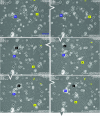Cardiac telocytes: serial dynamic images in cell culture
- PMID: 21114764
- PMCID: PMC4373489
- DOI: 10.1111/j.1582-4934.2010.01185.x
Cardiac telocytes: serial dynamic images in cell culture
Abstract
Telocytes (TC) are interstitial cells with telopodes (Tp). These prolongations (Tp) are quite unique: very long (several tens of micrometres) and very thin (≤0.5 μm), with moniliform aspect: thin segments (podomeres) alternating with dilations (podoms). To avoid any confusion, TC were previously named interstitial Cajal-like cells (ICLC). Myocardial TC were repeatedly documented by electron microscopy, immunohistochemistry and immunofluorescence. TC form a network by their Tp, either in situ or in vitro. Cardiac TC are (completely) different of 'classic' fibroblasts or fibrocytes. We hereby present a synopsis of monitoring, by time-lapse videomicroscopy, of Tp network development in cell culture. We used a protocol that favoured interstitial cell selection from adult mouse myocardium. Videomicroscopy showed dynamic interactions of neighbour TC during the network formation. During their movement, TC leave behind distal segments (podomeres) of their Tp as guiding marks for the neighbouring cells to follow during network rearrangement.
© 2010 The Authors Journal compilation © 2010 Foundation for Cellular and Molecular Medicine/Blackwell Publishing Ltd.
Figures




References
-
- Suciu L, Popescu LM, Gherghiceanu M, et al. Telocytes in human term placenta: morphology and phenotype. Cells Tissues Organs. 2010;192:325–39. - PubMed
-
- Popescu LM, Gherghiceanu M, Kostin S. Telocytes and heart renewing. In: Wang P, Kuo C-H, Takeda N, Singal PK, et al., editors. Adaptation biology and medicine. New Delhi, India: Narosa Publishing House Pvt. Ltd; 2010. pp. 17–39.
MeSH terms
LinkOut - more resources
Full Text Sources

